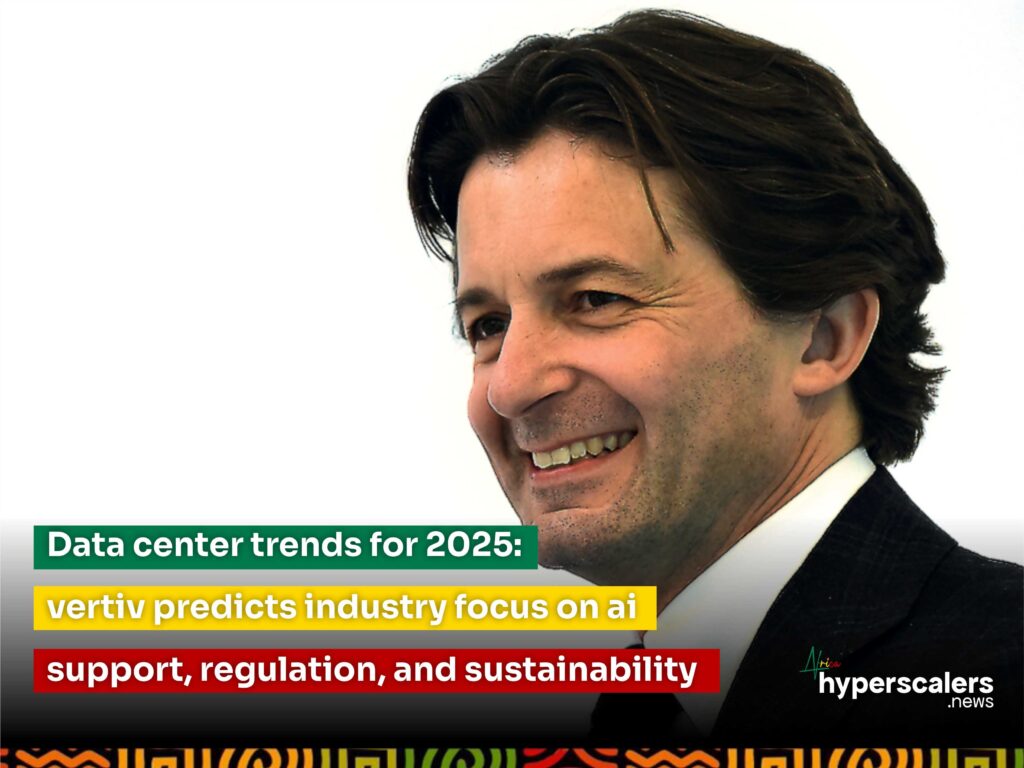Innovation in AI-powered infrastructure, energy management, and cooling strategies to take center stage in the new year.
– As artificial intelligence (AI) continues to reshape industries, its impact on data centers is becoming more pronounced. Vertiv (NYSE: VRT), a global leader in critical digital infrastructure and continuity solutions, has outlined its 2025 data center trends, emphasizing a wave of innovation aimed at supporting high-density AI workloads, addressing regulatory pressures, and promoting sustainability and energy efficiency.
“Our experts correctly identified the proliferation of AI and the need to transition to more complex liquid- and air-cooling strategies as a trend for 2024, and activity on that front is expected to further accelerate and evolve in 2025,” said Vertiv CEO Giordano (Gio) Albertazzi. “With AI driving rack densities into three- and four-digit kWs, the need for advanced and scalable solutions to power and cool those racks, minimize their environmental footprint, and empower these emerging AI Factories has never been higher. We anticipate significant progress on that front in 2025, and our customers demand it.”

The following key trends are expected to shape the data center industry in 2025, according to Vertiv experts:
The increasing demands of compute-intensive workloads will continue to place strain on existing data center power and cooling systems. As AI workloads shift to more powerful GPUs with higher thermal design points, traditional cooling methods will struggle to keep up. This will push data centers toward advanced solutions, including cold-plate and immersion cooling at the rack level, especially as AI adoption extends beyond early cloud and colocation providers into enterprise data centers. Racks will also require more robust uninterruptible power supply (UPS) systems and power distribution equipment to handle fluctuating loads from AI operations. Hybrid cooling systems, such as liquid-to-liquid, liquid-to-air, and liquid-to-refrigerant, will become more common in rackmount and row-based cabinet models.
As AI usage grows, so will the power consumption of data centers. Globally, data centers currently account for 1-2% of the world’s total power consumption, but AI is expected to drive this figure to 3-4% by 2030. This rise in energy demand is already placing pressure on overburdened grids and may lead to regulatory scrutiny, including potential restrictions on energy use and rising costs and carbon emissions. To mitigate these issues, data center operators will need to adopt more energy-efficient solutions and explore alternatives such as fuel cells, microgrids, and even small modular reactors (SMRs) for power generation.
With the rapid increase in AI-driven rack densities, predictions suggest racks could soon reach 500 to 1000 kW or more, a significant disruption for the data center industry. To support these extreme workloads, chip developers, data center operators, utilities, and infrastructure manufacturers will need to collaborate more closely. This collaboration will involve creating transparent roadmaps for AI adoption, developing AI-powered tools to speed up engineering and manufacturing, and establishing partnerships that integrate IT with infrastructure. As AI adoption grows, the collaboration between infrastructure providers and customers will be key to ensuring the development of robust, scalable solutions.
While AI brings tremendous benefits, it also introduces new challenges in cybersecurity. Cybercriminals are increasingly leveraging AI to enhance their attacks, making them more frequent, sophisticated, and widespread. AI-supported attacks now often target control systems, embedded devices, and infrastructure not typically subject to stringent security standards. In response, cybersecurity experts, network administrators, and data center operators will need to employ AI-driven security technologies to keep pace with evolving threats. As the frequency and sophistication of attacks rise, data centers will need to develop stronger, more adaptive defense mechanisms.
While regulations in 2023 focused primarily on energy consumption, 2025 is expected to see a growing focus on regulating AI itself. Governments and regulatory bodies worldwide are rushing to establish frameworks for AI governance, including how AI should be used, developed, and deployed. Initiatives like the European Union’s Artificial Intelligence Act and China’s Cybersecurity Law are setting the stage for more comprehensive regulatory oversight of AI. As concerns about AI’s energy use and environmental impact rise, regulations may extend to how AI applications are deployed and the energy consumption of data centers supporting them. Although AI regulation will continue to be largely regional or local in 2025, there may be more consistency in enforcement and tighter controls on both AI usage and resource consumption.
The trends outlined by Vertiv for 2025 highlight the growing complexity and urgency of addressing AI’s impact on the data center industry. As AI continues to drive innovation, sustainability, and regulatory efforts will remain top priorities for the sector.





